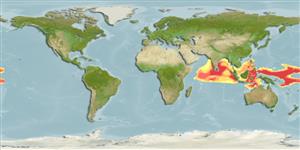Klassifizierung / Names
Namen | Synonyme | Catalog of Fishes(Gattung, Arten) | ITIS | CoL | WoRMS | Cloffa
>
Stomiiformes (Lightfishes and dragonfishes) >
Stomiidae (Barbeled dragonfishes) > Melanostomiinae
Etymology: Eustomias: Greek, eu = good + Greek, stoma = mouth (Ref. 45335); paxtoni: Named for John R. Paxton, for his contributions to the knowledge of pelagic fishes (Ref. 45801).
Environment: milieu / climate zone / depth range / distribution range
Ökologie
seewasser bathypelagisch; tiefenbereich 0 - 1250 m (Ref. 45801). Deep-water
Indo-West Pacific: in equatorial waters.
Size / Gewicht / Alter
Maturity: Lm ? range ? - ? cm
Max length : 20.7 cm SL (female)
Kurzbeschreibung
Morphologie | Morphometrie
Barbel with medial branch arising from stem and a pair of lateral branches arising from medial branch distal to its origin; medial branch stout, almost as thick as stem, terminating in rounded tip lacking filaments; lateral branches tiny, short filaments; terminal bulb protruding strongly dorsad, ovoid in lateral profile; three long medial terminal filaments on distal end of bulb; a pair of dorso-lateral terminal filaments terminating in small but prominent spheroids (Ref. 45801).
Life cycle and mating behavior
Geschlechtsreife | Fortpflanzung | Ablaichen | Eier | Fecundity | Larven
Clarke, T.A., 2001. Pelagic fishes of the genus Eustomias, subgenus Dinematochirus (Stomiidae), in the Indo-Pacific with the description of twelve new speices. Copeia 2001(3):683-699. (Ref. 45801)
IUCN Rote Liste Status (Ref. 130435)
Bedrohung für Menschen
Harmless
Nutzung durch Menschen
Mehr Information
NamenSynonymeMetabolismusRäuberÖkotoxikologieFortpflanzungGeschlechtsreifeAblaichenSpawning aggregationFecundityEierEientwicklung
Alter/GrößeWachstumLänge-GewichtLänge-LängeLängenhäufigkeitenMorphometrieMorphologieLarvenLarven Pop.Dyn.RekrutierungDichteBRUVS
ReferenzenAquakulturAquakultur ProfilZuchtlinienGenetikElectrophoresesVererbbarkeitKrankheitenVerarbeitungNutrientsMass conversion
PartnerBilderStamps, Coins Misc.LauteCiguateraGeschwindigkeitSchwimmstilKiemenoberflächeOtolithsGehirngrößeSehfähigkeit
Tools
Zusatzinformationen
Download XML
Internet Quellen
Estimates based on models
Preferred temperature (Ref.
123201): 7.7 - 18.4, mean 11.5 °C (based on 75 cells).
Phylogenetic diversity index (Ref.
82804): PD
50 = 0.5000 [Uniqueness, from 0.5 = low to 2.0 = high].
Bayesian length-weight: a=0.00302 (0.00117 - 0.00783), b=3.12 (2.89 - 3.35), in cm total length, based on LWR estimates for this (Sub)family-body shape (Ref.
93245).
Trophic level (Ref.
69278): 4.5 ±0.80 se; based on food items.
Widerstandsfähigkeit (Ref.
120179): mittel, Verdopplung der Population dauert 1,4 - 4,4 Jahre. (Preliminary K or Fecundity.).
Fishing Vulnerability (Ref.
59153): Low vulnerability (15 of 100).
